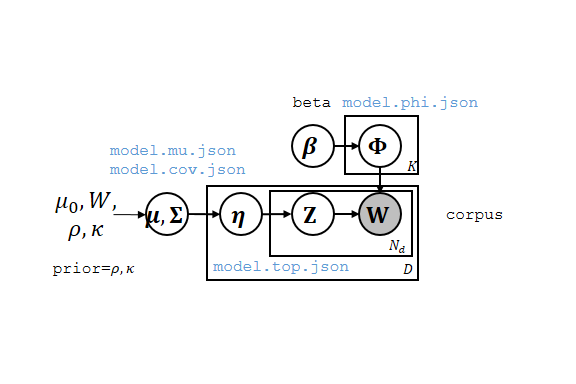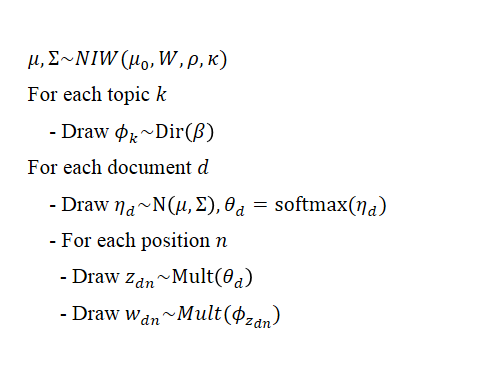Correlated Topic Model is a topic model for text or other discrete data that models correlation between the occurrence of different topics in a document (Figure 1).
ScaCTM is software that learn Correlated Topic Model of thousands of topics from millions of documents, with tens of machines.
Figure 1. Correlated Topic Model. (Blue monospace: output file names, Black monospace: input parameter names)
The generative model is described as follows.
Below is the speed of ScaCTM on some corpus. For more details, please refer to our paper.
| corpus | number of documents | number of topics | time |
| NIPS | 1.2K | 100 | 8.9 min |
| 20NG | 11K | 200 | 9 min |
| NYTimes | 285K | 400 | 0.5 hrs |
| Wiki | 6M | 1000 | 17 hrs |
Assume you already have BLAS and LAPACK installed, to build ScaCTM, simply do
cd third_party
make # Install third-party dependencies, takes 6 minutes on our 12-core server
cd ..
cd src
make -j # Build ScaCTM in parallel
cd ..
See BLAS if you don't have BLAS and LAPACK.
Chinese users: if you have trouble installing, see this.
For offline installation, download everything in https://github.com/cjf00000/ScaCTM/releases, put them in third_party/third_party/src, then do the normal installation sequence above.
First you need to set some environment variables
source scripts/setenv_bash # for bash
source scripts/setenv_csh # for csh
Then, copy ScaCTM to every nodes of cluster. We assume you have two nodes, juncluster1 and juncluster2, and ScaCTM is stored at juncluster1:ScaCTM
scp -r ScaCTM juncluster2:
Note: you need to execute source scripts/setenv_<your shell> in every shell session.
Download the example data, from Yahoo-LDA
mkdir work && cd work # We'll do everything in work/
wget https://raw.github.com/sudar/Yahoo_LDA/master/test/ydir_1k.txt
Now, take a look at the data. Every document is a single line in the file, every line is
docid site word_1 word_2 ...
You need to make sure that docid is unique. site is not used by ScaCTM currently, just for compatibility with Yahoo-LDA. Followed by these two fields are all the words in the corpus. You may wish to do some pre-processing, e.g. remove stop words.
First, open a file machinefile, put the following lines
juncluster1
juncluster2
Which are the hostnames for your cluster.
Look at help of ctm-train
ctm-train --help
Now we want to train a model with default parameters
ctm-train -f machinefile ydir_1k.txt
If you only have one machine, use
ctm-train ydir_1k.txt
The training is now started, you will see its progress on your console
Training on juncluster1, juncluster2 (2 nodes).
Distributing executables...
Done (7.418916 seconds).
Starting server...
Formatting corpus ydir_1k.txt...
Done (1.675312 seconds).
Training
100.000000%
Done (68.470395 seconds).
Gathering results...
Done (13.113103 seconds). Model stored in /home/jianfei/tmp/ScaCTM/work/ydir_1k.txt.model.
When the training is completed, the result in stored in ydir_1k.txt.model/info
model.topToWor.txtis learned topicsmodel.dict.jsonis a list of dictionary / vocabularymodel.phi.jsonis a V * K matrix phi, where V is vocabulary size and K is number of topics. phi[v, k] = p(w=v | z=k, phi) is the probabilty of word v of topic k. Word v is the v-th line inmodel.dict.json.model.mu.json,model.cov.jsonare prior mean and covariance.model.corr.jsonis the correlation matrix.model.top.jsonis the topic distributionetafor each document. It usesdocidprovided in data as key andetaas value.
We need a training set and testing set
make_test_data.sh ydir_1k.txt ydir_1k.txt.train ydir_1k.txt.test 0.8
You'll get a training set and a testing set with 8:2 documents.
Train
ctm-train -f machinefile ydir_1k.txt.train
Test
ctm-test -m ydir_1k.txt.train.model/ ydir_1k.txt.test
Test result is stored in ydir_1k.txt.test.result/info.
Sometimes you want to measure the perplexity on a test set. You need to further divide every document in the test set into an observed part and a heldout part. We'll infer eta on the observed part and measure perplexity on the heldout part. See the paper for detail.
make_test_data.sh ydir_1k.txt ydir_1k.txt.train ydir_1k.txt.test_observed 0.8 ydir_1k.txt.test_heldout
You'll get a training set and a testing set with 8:2 documents, the test set is further divided into an observed part and a heldout part.
Train
ctm-train -f machinefile ydir_1k.txt.train
Test
ctm-test -m ydir_1k.txt.train.model/ --heldout ydir_1k.txt.test_heldout ydir_1k.txt.test_observed
Perplexity is shown at the bottom.
Testing on juncluster1, juncluster2 (2 nodes).
Distributing executables...
Done (3.956380 seconds).
Broadcasting model...
Done (2.808829 seconds).
Starting server...
Formatting corpus ydir_1k.txt.test_observed...
Done (0.642709 seconds).
Testing
100.000000%
Done (4.367594 seconds).
Gathering results...
Done (4.367329 seconds). Output stored in ydir_1k.txt.test_observed.result.
Computing held-out perplexity
Perplexity = 1112.114460
If you don't have BLAS and LAPACK, you can simply install them by package manager, for example
sudo apt-get install libblas-dev
sudo apt-get install liblapack-dev
will install Netlib reference implementation on Ubuntu systems.
If you are working with a lot of short documents and many topics (>=500), you may wish to use a faster BLAS. There are many possible options, for example, to install ATLAS
sudo apt-get install libatlas3-dev
and rebuild the code
cd src
make clean && make -j
make sure ATLAS is used by ScaCTM
# See which BLAS is ScaCTM using
$ ldd /bin/learntopics
<skipped>
libblas.so.3gf => /usr/lib/libblas.so.3gf (0x00007f7c770e0000)
<skipped>
# Find the path of /usr/lib/libblas.so.3gf
$ ls -l /usr/lib/libblas.so.3gf
/usr/lib/libblas.so.3gf -> /etc/alternatives/libblas.so.3gf
$ ls -l /etc/alternatives/libblas.so.3gf
/etc/alternatives/libblas.so.3gf -> /usr/lib/atlas-base/atlas/libblas.so.3gf
if you are still using the old BLAS, you can manually link with ATLAS by modifing LDFLAGS in src/Makefile. You can also use other BLAS such as MKL or ACML by modifing INCFLAGS and LDFLAGS in src/Makefile.
Be cautious with OpenBLAS, we find ScaCTM works extremely slow with OpenBLAS.
Please create a issue for us if you found any bugs or want any new features. We look forward for your suggestions!
ScaCTM is built upon the Yahoo-LDA, which is a distributed framework for topic modeling.
Apache License 2.0
Please cite our paper if you find ScaCTM is useful!
Jianfei Chen, Jun Zhu, Zi Wang, Xun Zheng, and Bo Zhang. Scalable Inference for Logistic-Normal Topic Models, Advances in Neural Information Processing Systems (NIPS), Lake Tahoe, USA, 2013. (NIPS 2013)
Some demonstration can be found at http://ml.cs.tsinghua.edu.cn/~scalable-ctm/.

